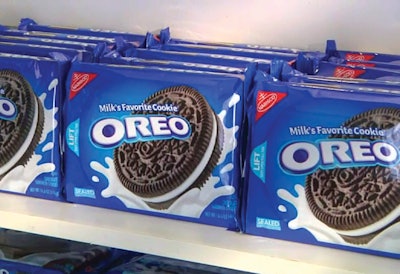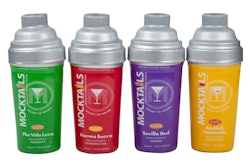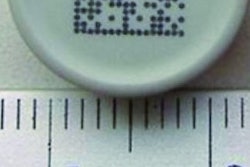Ask any packaging system owner to come up with a “wish list” of things that would help improve the quality of their operations, and it’s likely that information will rank near the top.
And no wonder. Information, after all, is the cornerstone of 21st Century productivity and profitability. It’s what helps system owners identify, plan, and validate system improvements and changes; benchmark performance against overall equipment effectiveness (OEE) and other goals; and spot opportunities to eliminate inefficiencies, even the most minor of which can undercut a well thought-out continuous improvement initiative.
Today’s controls systems and associated infrastructure can provide packagers with all that information—and more—on virtually any aspect of system performance imaginable, from the individual machine to across the entire enterprise. To get it, all a packager needs to do is “ask.”
Access to all that quality information—and more—is at the heart of the plans for Mondelez International to completely re-engineer its packaging lines, part of the Deerfield, IL-based snack food manufacturer’s global transformation of its manufacturing platforms.
Having adopted the Integrated Lean Six Sigma approach to process improvement company-wide, Mondelez International relies on information to ensure that new equipment and technologies that will be integrated into new processes—part of an ongoing project called the “Line of the Future—will fulfill their intended objective of driving out waste and inefficiency while also bolstering the quality and productivity necessary to increase their gross margin and foster further growth.
Werner Badtke, Program Manager for Automation and Manufacturing Systems at Mondelez International, uses the streamlining of the company’s process for baking the popular Oreo cookies as an example of one way the company is reinventing its global supply chain.
“Recipe and process changes enable us to eliminate major components, such as a 60-meter long cooling tunnel,” Badtke explains. “That results in a machine with a smaller footprint, and a more flexible set-up.”
Opportunities and constraints
The company’s ambitious objectives for its Line of the Future program are not unlike those of other CPG companies seeking to optimize the OEE of new and existing lines. Not surprisingly, it also shares some of the same implementation challenges when integrating smart machines into a smart manufacturing environment.
One of the biggest challenges revolves around performance management integration with and among the Line of the Future’s machine elements. Each major component of a packaging line has its own performance “story to tell,” which is defined in part by the packager’s line-, facility-, and/or enterprise-specific OEE data requirements, and the control technology being used.
Timing benefitted Mondelez International, as planning for the Line of the Future coincided with the emergence of PackML, enabling the company to match its requirements against the capabilities of the open-source control programming standard.
Despite PackML’s programming efficiencies, however, sequencing a line’s operation and inter-machine control to meet these requirements nevertheless requires custom coding during the integration process.
While integrators can reuse bits and pieces of code, and utilize repeatable engineering tools to help expedite the line integration process, “it’s still a really big effort to figure out what the OEMs did and then go into their code to then configure how the line needs to run,” says Matt Schroeder, a global account team leader with RockwellAutomation. He adds that packagers still need to add in a way to collect and process OEE data.
“PackML closes the gap,” Schroeder says “but by itself, it doesn’t give you OEE.”
All of this, of course, requires an investment of time and effort—a factor that didn’t exactly fit with the vision Mondelez International has for an expedited worldwide roll-out of new, highly flexible packaging lines in a connected-enterprise environment. Indeed, while the company has relied on standard designs for its lines, product- and facility-driven deviations that incorporate singular characteristics caused delays in startup and drove up costs.
To ensure the Line of the Future avoided those shortcomings, the company needed a cost-effective solution that provided performance management and line control in a standard yet flexible solution from the outset.
“We wanted vertical start-up support for new lines that could be implemented using a ‘copy/paste’ approach,” Badtke says, one where a copy of an existing system could be implemented quickly and easily by “pasting” it into a partially installed or configured system, making the implementation process easier and less prone to mistakes with each new addition. “And we needed full support for what would be a global implementation,” Badtke adds.
Expediting a transformation
That may sound like a tall order for any solution to fulfill, which is why Mondelez’s search for a suitable answer spanned a wide range of OEE reporting software packages, including those already in use and others that had appeared on the market. One that showed particular promise was RAPID, Rockwell Automation’s integrated line control and line performance management and line control system.
Using a common equipment interface based on PackML/ISA-88 standards, RAPID enables users to configure, control, and analyze line performance from a standard operator station, thereby reducing the total cost and time of deploying and optimizing packaging lines. What’s more, its built-in OEE reporting capability eliminated the need to incorporate additional reporting software after the line is set up. It represents a major departure from the traditional approach of integrating the line control first and the performance management later.
Schroeder notes that RAPID doesn’t supersede or eliminate the integration process. “It simply makes things easier,” he says. “RAPID leverages PackML at its core, while providing a faster, easier way to integrate project- or user-specific specifications.”
While RAPID initially wasn’t a ready-made “perfect solution” to the company’s needs, Mondelez International worked with Rockwell on enhancements that ultimately led to the adoption of RAPID as its global line integration standard for the Line of the Future.
“RAPID is not only a software package, it’s a full concept,” Badtke says. “You have a supervisory system that consists of a server, a client view, and a performance view, which means you have all the information necessary to collect into reports. There’s no need for a programming tool. It’s completely plug and play.”
One of the most appealing aspects of RAPID to the Line of the Future initiative is its ability to vastly simplify and standardize line integration.
Rather than going through the process of writing new PLC code to establish machine-to-machine communication for each line, RAPID allows the end user to set up each line’s supervisory control structure via an HMI, automatically incorporating the appropriate PLC code for selected data block definitions and applications, such as line balancing, equipment recipes, changeover coordination, or energy management.
“It’s more of a configuration exercise with check boxes than integration, which eliminates a lot of custom PLC modification work,” says Badtke. “The machine is there or it’s not. You type in its properties and what you want it to do for each product it runs, and the PLC is coded accordingly.”
Badtke adds that users also can perform dynamic event configuration for each PackML status for a machine, and how it affects others in the line. “For example,” he says, “you can define what one machine should do if the downstream machine is faulted—stop immediately or after a few minutes.”
Then, of course, there’s collecting and managing that all-important performance information. Because RAPID facilitates the collection of vast amounts of PackML status data, Mondelez International can compare OEE for a particular product on multiple machines across multiple days and/or locations, providing a more comprehensive analysis of machine and line performance over a specified period of time—status changes and durations, fault causes, and other function-critical statistics.
Badtke cites a RAPID-generated pareto chart of down times as being especially helpful to the 80/20 approach that is central to the Six Sigma initiative at Mondelez International.
“This information helps us more easily identify and focus on resolving the faults representing 80 percent of the downtime, which are considered more critical than the minor faults that account for only 20 percent,” Badtke explains.
Similar to providing a standard approach to line integration, RAPID provides a standard set of production management capabilities that makes it easier for the line to exchange data with and take orders from a new or existing management execution system (MES) and enterprise resource planning (ERP) software.
“Scheduling functions, such as the order of products or downtime for cleaning, can be issued without having to make any changes to the line control because it’s all modeled using RAPID,” Badtke. “The lines can receive a packaging order to produce a specific amount of a specific product during a specific period. RAPID does the rest.”
Badtke says the company is currently considering the Rockwell CPG Suite in addition to Simatic IT production suite as the standard MES counterpart to new Lines of the Future. “We want a system that will provide the best complement for our ‘cut and paste’ approach to deploying new lines,” he says.
Building momentum
Mondelez International plans to implement its RAPID-supported Line of the Future concept for a variety of product types at both existing and new facilities. The lines are already in operation in a number of cities.
Badtke notes that while RAPID offers great value to the Line of the Future, it doesn’t require an all-or-nothing commitment for the company’s long-term growth strategy. Because there are always exceptions when it comes to facilities and products and packaging equipment, the company plans to keep its options open when considering controls technologies for new projects.
“RAPID will be the standard for every Line of the Future project,” he says. “Where there are specialized requirements involved, the project leaders or the plant can decide whether to use a different standard.”
That approach gives Mondelez International the best chance at realizing another common, coveted attribute on every packager’s wish-list: flexibility to meet the demands of an ever-changing, highly competitive marketplace.
“It’s all part of a continuous cycle, whereby leveraging a common, simple technology platform will help us save money, which can then be reinvested in growth to help us focus on our ‘power brands and priority markets,’” Badtke says. “We’re confident this approach will be instrumental in helping us achieve our business, operational, and quality goals.”


























